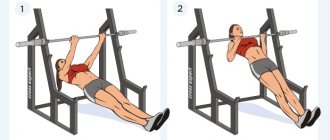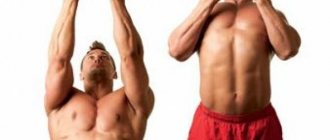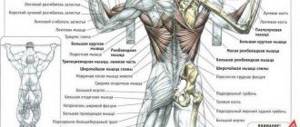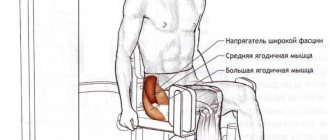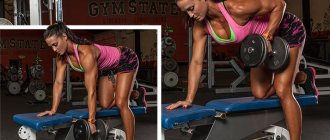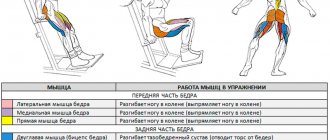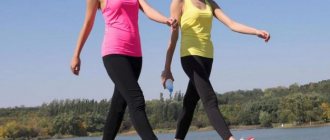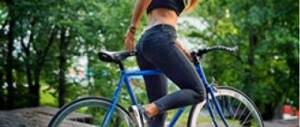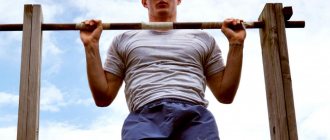What is a pull-up
This is one of the best universal exercises that can build muscle mass, increase body endurance, and improve health. During this exercise, a person grabs the bar of the horizontal bar and hangs on straight arms, after which, bending his arms at the elbows, he lifts his body up until his arms are completely bent at the elbows (the chin should go above the bar, and the bar itself should be at shoulder level). At the same time, all the back and shoulder muscles are fully involved when pulling up and develop harmoniously.
Such movements are natural for a person; he was created with this skill. Their lives depended on the strength of the backs and arms of primitive hunters, the ability to lift their bodies and throw them over an obstacle. Now this exercise is the safest from the point of view of natural biomechanics, since it does not injure the spine, but, on the contrary, stretches it, helps strengthen cartilage and stimulates the production of synovial fluid in the intervertebral capsules. With systematic training using various types of grips, the muscle corset is strengthened.
Per head
Athletes recommend using head pull-ups to pump up your back, along with traditional methods. Pulling yourself up by your head is much more difficult, since more muscles are involved in the process:
- lats;
- trapezoidal;
- diamond-shaped;
- round dorsal;
- neck muscles;
- biceps;
- rear deltoids;
- brachialis.
As a rule, a wide head grip is used. This method works great on the lats and upper back. You can use a narrow and medium grip, but there are opinions that they are not effective for developing the back. In addition, you need to monitor your sensations - these types of training are dangerous. If you do not feel any discomfort, then continue exercising, taking into account that pulling yourself up by the head with any grip is generally prohibited for people with an injured neck and shoulder girdle injuries.
To the chest
One of the effective exercises for developing back relief is chest pull-ups. In this exercise, two movements that are anatomically convenient for the back are performed: bringing the elbow joint to the body with the elbows moving back and bringing the shoulder blades together. Thanks to these movements, all muscle groups of the back are involved, which affects the rapid development of strength characteristics and appearance. Activated:
- lats;
- diamond-shaped;
- trapezoid;
- round large and small;
- anterior and posterior serrations;
- biceps;
- forearms;
- press.
The introduction of all these groups into work simultaneously leads the body to severe stress, to which the latter responds with adaptation, which is expressed by the rapid growth of muscle mass and an increase in strength. When pulling to the chest, the work of the muscles is controlled to eliminate jerking and inertial movement when performing a traditional lift to the chin. The main thing in this exercise is the execution technique.
What muscles are involved when doing pull-ups on the horizontal bar?
To perform this complex exercise, several muscle groups are involved at the same time, movement occurs in the shoulder and elbow joints. The work of the muscles when pulling up on the horizontal bar begins with activating the hands, fingers, and forearms to make a secure grip on the bar. After which paired large shoulder, back, and shoulder girdles are included in the work.
Back muscles
- Pull-ups for the latissimus dorsi muscles play an important role in physical development. They are responsible for the ability to rotate the arms in the shoulder joints to the center and inside the body, they move the arms behind the back, back and to the center of the body. Athletes called them “wings.”
- The next muscle group is the trapezius or trapezius muscles. They are located at the base of the skull, extending down to the middle of the back and to the sides diagonally to the shoulder joints from the thoracic spine. The trapezius moves the shoulder blades and supports the arms. Well-pumped trapezius muscles form a beautiful pattern on the back in the form of an inverted herringbone.
- The deltoids are responsible for the beauty, strength and contour of the shoulders. They consist of an anterior middle (lateral) and posterior bundle. Exercises on the horizontal bar develop only the posterior bundles; they do not fundamentally affect the others, but they do have a strengthening effect.
Abdominal muscles
The main muscle group of the abdominal wall is the abs, these are those coveted squares on the abdomen, and in addition, the oblique, transverse and erector torso muscles. This muscle group is functionally important for the human body and is responsible for movement, stabilization during exercise, and maintaining posture in a standing and sitting position. Strong abdominal muscles during pull-ups are a reliable foundation for body development and the key to successfully performing exercises on the bar.
Arm muscles
Pull-ups on the arm muscles are just as effective as on the back muscle groups. The forearm consists of finger flexors/extensors, brachioradialis for bending the arms at the elbows, pronators for turning the palms down, and supinators (turning the palms up). These muscles help make a secure grip on the bar with your hands. The biceps are auxiliary, thanks to which the rotational movement of the forearms and flexion of the elbows occurs.
Additional exercises
A special crossbar with curved edges allows you to perform pull-ups with maximum amplitude - in this exercise, the rhomboid and round muscles of the back, hidden under the trapezius, and the brachioradialis muscle of the forearm effectively work. This exercise is best performed towards the end of the workout, as it is most suitable for working out the back.
Pull-ups on a horizontal bar with curved handles
Knowing now which muscle groups are tensed and involved in the work when performing a particular exercise on the horizontal bar, it is easier to create a balanced physical training program. Try to load your muscles evenly, alternating different types of pull-ups, and then your body will look harmonious and beautiful, and you will feel strong and healthy.
What muscle groups work when pulling up?
Depending on the type and grip used, different muscle groups work. In general, the following muscle groups are activated during a pull-up:
- dorsal;
- chest;
- shoulder;
- arm muscles
However, it is not enough to know about the muscle groups involved in the exercise. If the execution technique is incorrect, then the training will not only not be beneficial, but will become dangerous:
- According to observations, when beginners perform the exercise, they throw their head back, lift their chin, reach for the bar, jerking their legs, as if they are trying to climb an invisible ladder. Many more amateur athletes instinctively throw their body up as they inhale, squeezing their shoulders together. This absolutely cannot be done, otherwise you can damage the cervical vertebrae and develop an intervertebral hernia.
- It is necessary to monitor your breathing. Before going up, take a deep breath, hold your breath and rise, exhaling the air at the top. This will make it easier for the lats to work, and they will push your body up. In addition, holding your breath will help keep the small back muscles intact from straining.
Straight grip
In the traditional way, they do pull-ups even in physical education classes in schools, without thinking about which muscles work when doing pull-ups with a direct grip. Only after a while with regular training do reliefs on the body become noticeable. A direct grip on the horizontal bar means fixing your hands on the bar with your palms facing away from you. This exercise works the muscles in the back, forearm flexors, biceps, triceps and shoulder muscles.
Reverse pull-ups
Exercises that use a reverse grip on the horizontal bar are easier to perform. Beginners learn this type of exercise more easily because their shoulders and back are not yet sufficiently developed, and their arms (biceps) are stronger. Therefore, a reverse grip is recommended, which mainly works the biceps. Gradually, in this exercise you can pump up the broad back muscles. To perform the exercise correctly, you need to turn your palms towards you and grab the bar, your shoulders slightly pulled back.
- How to draw a family tree: templates and programs
- Chicken manure as fertilizer
- Chicken legs in the oven: delicious recipes
Parallel grip
Pull-ups with a parallel grip or, in other words, neutral, when one palm is turned towards you, the other away from you, are designed to develop the lower sections of the latissimus muscles. To do this, during the execution the range of movements should be short, and the touch to the crossbar should occur with the chest. If, with a narrow grip, you make the maximum amplitude and touch the bar with your chin, then it is not the lats that work, but the biceps. The parallel grip is used as a finishing exercise after working the lats.
Important Tips
It is not enough to simply understand which muscles work when doing pull-ups on the horizontal bar in order to achieve the desired result. It is extremely important to adhere to certain rules during training. Among the main ones:
- Swinging, inertia, and jerking are unacceptable.
- Ascents and descents are carried out as smoothly as possible.
- When the highest point is reached, the chin is located above the horizontal bar.
- Just keep your head straight.
- The grip is as strong as possible.
Another important point is the correct preparation of a training regimen. For example, they can be done three times a week. Each day will have a different load:
- Three approaches are performed with a reverse narrow grip with the maximum possible number of times in each set. The same number of approaches is done with a wide grip behind the back.
- On the second day, do three sets of the maximum number of times with an average grip.
- The third training is carried out in a light mode. Overworking of muscle tissue is unacceptable. It is enough to perform three sets of just ten pull-ups.
You need to work in this mode for at least a month. Then you can slightly increase the load and additionally use weighting agents. Thanks to these actions, muscle mass will build up much faster.
Types of pull-ups for different muscle groups
There are many types of pull-ups, where the emphasis is on specific muscle groups. The grip width of the bar, the way you position your hands, the vector and amplitude of movements determine which muscles work the most on the horizontal bar. In fact, all types are divided according to the following criteria:
- Grip width. A narrow grip if the athlete’s hands are fixed on the bar narrower than the shoulders. Medium grip – hands are shoulder-width apart or slightly wider. Wide grip - the distance between the hands is significantly greater than the width of the shoulders.
- The grip method is direct and reverse.
- Upper body position - pulling up to the chin, to the chest, behind the head.
The methods described above are basic; the technique of pulling up different types varies only slightly. The main thing is to train hard on the horizontal bar, learn to breathe correctly when doing the exercise, then your muscles will quickly get stronger and you can give your body heavier loads: with lifting and inversion, with rolling, dead, double and single, with clapping and other elements .
Wide grip
If you pull yourself up with a straight wide grip, you can successfully swing your trapezius, lats (upper part), and rounds. When pulling up behind the head with a wide grip, the trapezius, lats (lower part) and round pairs work. Wide-grip pull-up technique:
- Make a wide, straight grab of the crossbar.
- When bending your arms, you need to make sure that your forearms form a right angle with the bar of the horizontal bar, and your shoulders are kept parallel to it, and your thumb should be next to your palm, and not wrap the ring around the horizontal bar.
- We lift the body by bringing the shoulder blades together until the chest touches the bar.
Narrow grip
When pulling up with a straight narrow grip, the brachialis, lower back (latissimus), and serratus anterior muscles are pumped. Close grip pull-up technique:
- Direct grip on the bar.
- Palms almost touching each other
- Hang and arch your back slightly.
- Keep your legs crossed so as not to sway and make the exercise more difficult.
- Bend your arms, trying to reach your chin to the bar.
- Start a negative (reverse) movement. Lower yourself smoothly without jerking, fully extending your arms.
With a reverse narrow grip, the emphasis is placed on other muscle groups - the lower lats and biceps. For reverse pull-ups, the athlete needs to touch the lower part of their chest to the bar. Technique:
- Reverse grip of the bar - palms facing you, thumb closing the horizontal bar into a ring.
- Lifting the body is carried out with the help of the shoulder blades - you need to feel how the shoulder blades work when flattening, and try to reach the top point of the horizontal bar with your chest.
- Slow return to starting position.
Medium grip
Exercises with a classic medium grip pump up the shoulders, forearm flexors, triceps, biceps and back. The neutral grip pull-up is performed similarly to the direct grip technique described above, but the hands are shoulder-width apart. Touching the crossbar occurs with the upper chest, below is a full smooth straightening of the arms. With the classic reverse grip, the biceps and lats are pumped.
Execution technique
When doing pull-ups, as with any other sports element, you must follow a certain technique. Conventionally, it can be divided into three stages:
- Starting position;
- Middle of the exercise;
- Top position.
Let's look at each of them in detail.
Starting position
The first thing you must remember is that your back should never be relaxed while hanging from a horizontal bar. Grab the bar with your hands and extend them completely. The body should not hang around without tension. The shoulder girdle is always tense, this ensures that the main load will be directed specifically at it, and not at the biceps, which are much weaker.
Middle
When you have taken the starting position, begin to pull your body up. In this case, not only your hands, but also your shoulder blades should be used. Control your shoulder girdle. In the video below, the trainer explains in detail the reason why some people cannot do pull-ups with an overhand grip, but can with a reverse grip. Engage your entire shoulder girdle when doing pull-ups, this will increase the effectiveness of the exercise and make it much easier for you.
Top position
The moment your chin is above the bar, do not stop, continue to try to pull your body as high as possible. At this moment, your buttocks and abdominal muscles should be tense. During the execution, the torso may be slightly behind, and the hips and legs are in front of the bar - this is not a big problem. But you need to watch your shoulders carefully - do not push them in front of the horizontal bar, this can lead to injury.
What muscles work when doing pull-ups?
Do not confuse push-ups and pull-ups on parallel bars - they are not the same thing. When doing pull-ups on the uneven bars, the hands grasp the bars, the legs are above the head: brought to the chest (baby pose) or straightened vertically upward, the back is parallel to the floor. It turns out that you will perform pull-ups to the stomach. Trained athletes can do approaches with weights, which will be served by a backpack with a load. When working on parallel bars, the main load falls on the biceps. The deltoids, lats and abs get some training to keep your legs above your head.
Video about how to do pull-ups on a horizontal bar
What to do if you can’t pull yourself up? No matter how many repetitions you do, it’s all in vain, this exercise doesn’t work out... But you want to look pumped up in your own photo, and not lose face in front of your friends who have already conquered the horizontal bar! A training program following the execution technique will help you, which can be found in the following videos.
Pull-ups on the bar
